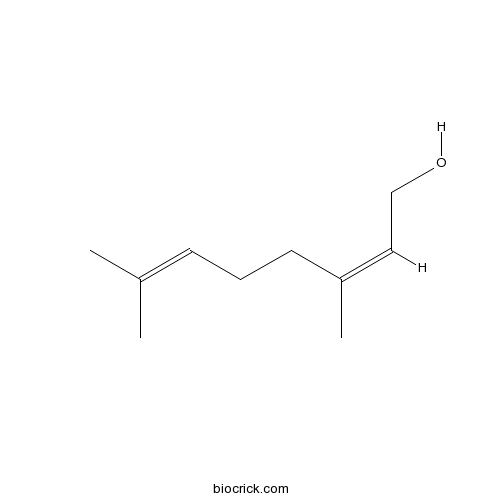NerolCAS# 106-25-2 |

- Geraniol
Catalog No.:BCN2631
CAS No.:106-24-1
Quality Control & MSDS
3D structure
Package In Stock
Number of papers citing our products

| Cas No. | 106-25-2 | SDF | Download SDF |
| PubChem ID | 643820 | Appearance | Colorless Liquid |
| Formula | C10H18O | M.Wt | 154.25 |
| Type of Compound | N/A | Storage | Desiccate at -20°C |
| Solubility | Soluble in Chloroform,Dichloromethane,Ethyl Acetate,DMSO,Acetone,etc. | ||
| Chemical Name | (2Z)-3,7-dimethylocta-2,6-dien-1-ol | ||
| SMILES | CC(=CCCC(=CCO)C)C | ||
| Standard InChIKey | GLZPCOQZEFWAFX-YFHOEESVSA-N | ||
| Standard InChI | InChI=1S/C10H18O/c1-9(2)5-4-6-10(3)7-8-11/h5,7,11H,4,6,8H2,1-3H3/b10-7- | ||
| General tips | For obtaining a higher solubility , please warm the tube at 37 ℃ and shake it in the ultrasonic bath for a while.Stock solution can be stored below -20℃ for several months. We recommend that you prepare and use the solution on the same day. However, if the test schedule requires, the stock solutions can be prepared in advance, and the stock solution must be sealed and stored below -20℃. In general, the stock solution can be kept for several months. Before use, we recommend that you leave the vial at room temperature for at least an hour before opening it. |
||
| About Packaging | 1. The packaging of the product may be reversed during transportation, cause the high purity compounds to adhere to the neck or cap of the vial.Take the vail out of its packaging and shake gently until the compounds fall to the bottom of the vial. 2. For liquid products, please centrifuge at 500xg to gather the liquid to the bottom of the vial. 3. Try to avoid loss or contamination during the experiment. |
||
| Shipping Condition | Packaging according to customer requirements(5mg, 10mg, 20mg and more). Ship via FedEx, DHL, UPS, EMS or other couriers with RT, or blue ice upon request. | ||

Nerol Dilution Calculator

Nerol Molarity Calculator
| 1 mg | 5 mg | 10 mg | 20 mg | 25 mg | |
| 1 mM | 6.483 mL | 32.4149 mL | 64.8298 mL | 129.6596 mL | 162.0746 mL |
| 5 mM | 1.2966 mL | 6.483 mL | 12.966 mL | 25.9319 mL | 32.4149 mL |
| 10 mM | 0.6483 mL | 3.2415 mL | 6.483 mL | 12.966 mL | 16.2075 mL |
| 50 mM | 0.1297 mL | 0.6483 mL | 1.2966 mL | 2.5932 mL | 3.2415 mL |
| 100 mM | 0.0648 mL | 0.3241 mL | 0.6483 mL | 1.2966 mL | 1.6207 mL |
| * Note: If you are in the process of experiment, it's necessary to make the dilution ratios of the samples. The dilution data above is only for reference. Normally, it's can get a better solubility within lower of Concentrations. | |||||

Calcutta University

University of Minnesota

University of Maryland School of Medicine

University of Illinois at Chicago

The Ohio State University

University of Zurich

Harvard University

Colorado State University

Auburn University

Yale University

Worcester Polytechnic Institute

Washington State University

Stanford University

University of Leipzig

Universidade da Beira Interior

The Institute of Cancer Research

Heidelberg University

University of Amsterdam

University of Auckland

TsingHua University

The University of Michigan

Miami University

DRURY University

Jilin University

Fudan University

Wuhan University

Sun Yat-sen University

Universite de Paris

Deemed University

Auckland University

The University of Tokyo

Korea University
- Geraniol
Catalog No.:BCN2631
CAS No.:106-24-1
- 2-(3,4-Dihydroxyphenyl)ethanol
Catalog No.:BCN5871
CAS No.:10597-60-1
- Sulfocostunolide B
Catalog No.:BCN5870
CAS No.:1059671-65-6
- Clinafloxacin CI96 AM1091
Catalog No.:BCC3754
CAS No.:105956-97-6
- OLDA
Catalog No.:BCC7138
CAS No.:105955-11-1
- STEARDA
Catalog No.:BCC7288
CAS No.:105955-10-0
- Doxycycline HCl
Catalog No.:BCC3772
CAS No.:10592-13-9
- Taraxasterol
Catalog No.:BCN5869
CAS No.:1059-14-9
- (tert-Butoxycarbonyl)oxycefcapene pivoxil
Catalog No.:BCC8403
CAS No.:105889-80-3
- Obtusilin
Catalog No.:BCN2697
CAS No.:105870-59-5
- TSTU
Catalog No.:BCC2828
CAS No.:105832-38-0
- Tropisetron Hydrochloride
Catalog No.:BCC4027
CAS No.:105826-92-4
- β-Interleukin I (163-171), human
Catalog No.:BCC1017
CAS No.:106021-96-9
- Palmatine hydrochloride
Catalog No.:BCN5914
CAS No.:10605-02-4
- Hoechst 33342 analog 2
Catalog No.:BCC1631
CAS No.:106050-84-4
- Senktide
Catalog No.:BCC6921
CAS No.:106128-89-6
- PND-1186
Catalog No.:BCC1866
CAS No.:1061353-68-1
- TC-G 1004
Catalog No.:BCC6165
CAS No.:1061747-72-5
- WAY-600
Catalog No.:BCC4607
CAS No.:1062159-35-6
- WYE-687
Catalog No.:BCC4604
CAS No.:1062161-90-3
- WYE-354
Catalog No.:BCC1059
CAS No.:1062169-56-5
- Ro3280
Catalog No.:BCC3962
CAS No.:1062243-51-9
- LDN-193189
Catalog No.:BCC3687
CAS No.:1062368-24-4
- ML347
Catalog No.:BCC5331
CAS No.:1062368-49-3
A receptor-neuron correlate for the detection of attractive plant volatiles in Helicoverpa assulta (Lepidoptera: Noctuidae).[Pubmed:29698698]
Insect Biochem Mol Biol. 2018 Jun;97:31-39.
Plant volatiles are vital cues in the location of hosts for feeding and oviposition for Lepidoptera moths. The noctuid Helicoverpa assulta is a typical polyphagous moth, regarded as a good model for studying the olfactory reception of plant volatiles. In this study, four full-length genes encoding odorant receptors HassOR24, HassOR40, HassOR41, and HassOR55 expressed in antenna in H. assulta were functionally characterized. The highly expressed HassOR40 was narrowly tuned to a few structurally-related plant volatiles: geranyl acetate, geraniol and Nerolidol. By systematically analyzing responses of single neuron in both trichoid sensilla and basiconic sensilla using single sensillum recording, the specific neuron B in one type of short trichoid sensilla was found to be mainly activated by the same chemicals as HassOR40 with high sensitivity, and with no significant difference between male and female neurons. Thus, a clear "receptor-neuron" relationship in H. assulta was demonstrated here, suggesting that HassOR40/HassOrco are expressed in neuron B of short trichoid sensilla. The active tobacco volatile Nerolidol, recognized by this receptor-neuron line, elicits significant behavioral attraction of both sexes in H. assulta adults. The results indicate that we identified a receptor-neuron route for the peripheral coding of a behaviorally relevant host volatile in H. assulta.


